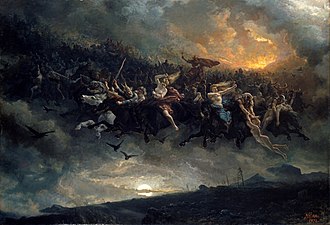
Back Wildes Heer ALS Cazataire maldito AN الصيد البري (أسطورة) Arabic Vəhşi ov Azerbaijani Wüde Jogd BAR Дзікае паляванне Byelorussian Cacera infernal Catalan Divoká honba Czech Den vilde jagt Danish Wilde Jagd German

The Wild Hunt is a folklore motif occurring across various northern, western and eastern European cultures, appearing in the religions of the Germans, Celts, and Slavs (motif E501 per Thompson).[1] Wild Hunts typically involve a chase led by a mythological figure escorted by a ghostly or supernatural group of hunters engaged in pursuit.[2] The leader of the hunt is often a named figure associated with Odin in Germanic legends,[3][4] but may variously be a historical or legendary figure like Theodoric the Great, the Danish king Valdemar Atterdag, the dragon slayer Sigurd, the Welsh psychopomp Gwyn ap Nudd, biblical figures such as Herod, Cain, Gabriel, or the Devil, or an unidentified lost soul either male or female. The hunters are generally the souls of the dead or ghostly dogs, sometimes fairies, valkyries, or elves.[5][6][7]
Seeing the Wild Hunt was thought to forebode some catastrophe such as war or plague, or at best the death of the one who witnessed it.[8] People encountering the Hunt might also be abducted to the underworld or the fairy kingdom.[a] In some instances, it was also believed that people's spirits could be pulled away during their sleep to join the cavalcade.[10]
The concept was developed by Jacob Grimm in his Deutsche Mythologie (1835) on the basis of comparative mythology. Grimm believed that a group of stories represented a folkloristic survival of Germanic paganism, but this is disputed by other, modern scholars who claim that comparable folk myths are found throughout northern, western and central Europe.[3] Lotte Motz noted, however, that the motif abounds "above all in areas of Germanic speech."[11] Grimm popularised the term Wilde Jagd ("Wild Hunt") for the phenomenon.
- ^ Thompson, Stith (1977). The Folktale. University of California Press. p. 257. ISBN 0-520-03537-2.
- ^ Greenwood 2008, p. 195.
- ^ a b Schön 2004, pp. 201–205.
- ^ Greenwood 2008, p. 196.
- ^ Briggs 1967, pp. 49–50.
- ^ Briggs 1978, "Wild Hunt", p. 437.
- ^ Greenwood 2008, pp. 195–197: "'Wild Hunt', a generic name given to numerous folk myths associated with ‘soul-ravening’ chases, often led by a god, goddess, or mythological figure accompanied by a cavalcade of souls of the dead ... In Teutonic mythology it is Woden (Odin or Wotan) who leads the hunt accompanied by fearsome ghostly dogs ... In some accounts, Woden is accompanied by beautiful spirit maidens called Valkyries or Waekyrges ... Herne the hunter, a descendant of Woden, is also said to lead a Faery pack across the hills of Britain ..."
- ^ See, for example, Chambers's Encyclopaedia, 1901, s.v. "Wild Hunt": "[Gabriel's Hounds] ... portend death or calamity to the house over which they hang"; "the cry of the Seven Whistlers ... a death omen".
- ^ Briggs 1978, "Infringement of fairy privacy", p. 233.
- ^ Hutton, Ronald (8 December 1993). The Pagan Religions of the Ancient British Isles: Their Nature and Legacy. Wiley. p. 307. ISBN 0-631-18946-7.
- ^ Motz, Lotte (1984). "The Winter Goddess: Percht, Holda and Related Figures". Folklore. p. 163.
Cite error: There are <ref group=lower-alpha> tags or {{efn}} templates on this page, but the references will not show without a {{reflist|group=lower-alpha}} template or {{notelist}} template (see the help page).
© MMXXIII Rich X Search. We shall prevail. All rights reserved. Rich X Search